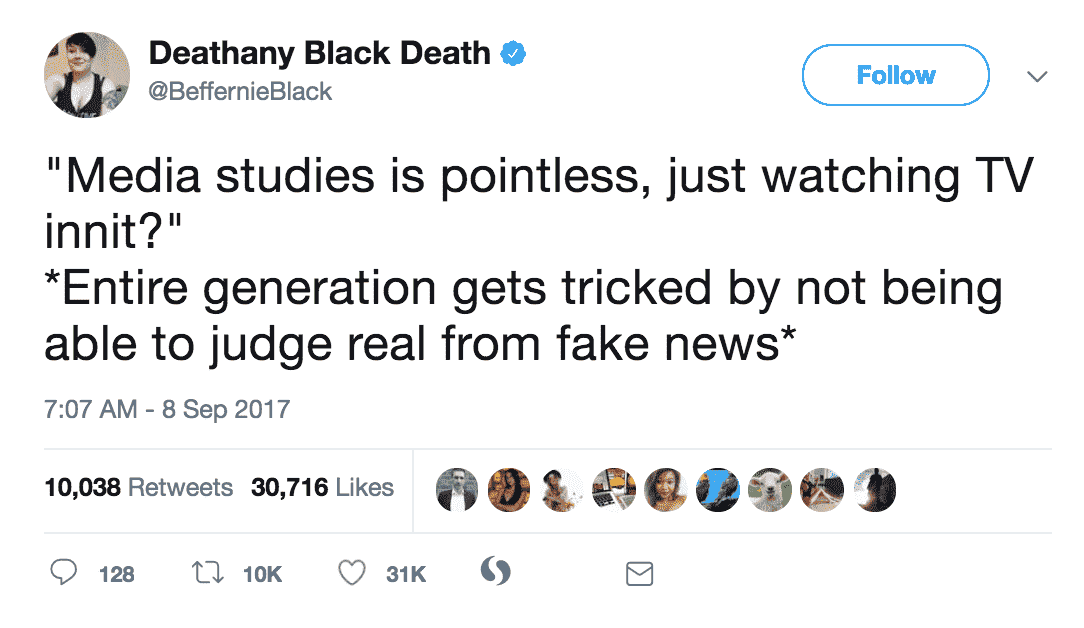A few weeks before writing this article I saw a tweet from British comedian, actress, and writer Bethany Black. It’s the kind of sentiment bound to get a graduate student in a learning media department nodding sagely.

Still, as a relative newcomer to the interdisciplinary field of media literacy education – little more than a bystander, to be honest – I should probably stick to just retweeting such thoughts and avoid the sweet temptations of the personal “I told you so.”
If there’s one religious media scholar who does have a right to such boasting in times like these – and, I suspect, would absolutely never exercise it – it’s Luther Seminary Professor of Educational Leadership Mary Hess.
For years, Hess has been a rare if not quite singular voice in theological education. She’s been inviting us to recognize that media cultures matter, including to people of faith and especially to those of us who teach in religious communities. Hess wrote the following in the introduction to her 2005 (yes, 2005) book Engaging Technology in Theological Education:
“To me, theological reflection lives and breathes amidst movies and music, in the interwoven webs of the Internet, and in the daily and quite ordinary ways in which digital technology is built into just about every form of media we now engage. If we are to teach and learn in contemporary culture, we have to engage these media.”
As a theological educator and a media literacy educator, Hess has been a living example of the kind of leadership consciousness we all need to develop in these days of Tweeting popes, religious blogger authority wars, and the digitization of Bible reading.
Media Literacy Education
We all know that faith formation ministers are strapped for time and resources. Why should they – why should you, dear reader – add media literacy education to your ministry toolbelt?
You probably won’t be surprised to learn that I made a list:
(1) The people we serve – including adults – are spending more and more time on their screens. We should be there in digital and hybrid spaces to meet them.
For educators who can walk the tightrope that spans playfulness and planfulness, the new media ecology offers perhaps unprecedented opportunities to reach faith learners from all walks of life. It’s not a panacea and it certainly isn’t easy, but the Internet is a place where people consider ideas and connect with their loved ones. That can make for a wonderful learning environment.
Incidentally, I’m not discounting that when we meet our people online, we might occasionally encourage them to spend a little less time on their screens. Helping guide generations of smartphone users into spiritually wise digital habits is a rich, meaningful, and urgent calling. But in this particular teaching role, I think Jesus is a better mentor than John the Baptist (see Matthew 11:19; Luke 7:34).
(2) Creating media is a much better learning activity than consuming media.
One of the core commitments of today’s media literacy educators is to encourage students to learn by doing. Yes, this can help us become detectives sleuthing out hidden messages in advertising and media releases.
But we should put those same skills to work in crafting our own statements on behalf of the causes we care about and the traditions we hold dear. As we embrace our calling as media literacy educators, we can help guide our communities toward becoming more effective advocates and evangelists.
The same goes for more traditional faith formation outcomes. I had the pleasure last summer to co-facilitate a media-making workshop with BimBam (formly G-dcast) founder Sarah Lefton. As she reflected with our students on what they had learned creating storyboards to animate famous proverbs, I was reminded that there’s no better way to teach a story than to help learners tell it themselves:
“I’d like to think that six months or a year from now, you will remember your proverb in a different way,” Lefton said. “You’ve gone pretty deep, you’ve made something you could share, and I hope you’ve observed a process you could use with your students.”
(3) Media-literate Christians can contribute to a culture of truth-telling, transparency, and responsible discourse in the public square.
We’re not going to singlehandedly change the cultural and social practices of the world’s spinmasters and power brokers. But since the first days of the early church, it has been a central part of Christian vocation and witness to resist patterns of domination and manipulation.
Whatever our political loyalties, the only Christian response to public discourse that would have made Orwell and Huxley blush is to model something different, teach our children and our peers something different. That will require our own continued formation and learning.
(4) Media cultures are fun and sometimes we should have that.
The first draft of this list had a lot more items cut for space, but I couldn’t bring myself to cut this one. To play, to laugh, to hope: these too are acts of resistance to what we (and most other generations, incidentally) have euphemistically labeled “Times Like These.”
Change is hard for religious people – perhaps cultural change particularly so. To be active, critical participants in the process can help us have our say in it. Such participation also gives us the chance to enjoy the journey as often as we can.
There are richer and poorer definitions of fun to be had among our media cultures. All of them have their place, and many of them can positively benefit us on our learning journeys. With their help, we can change our media literacy narratives from “too much, too big, too chaotic, too intractable” to something that evokes the guidance of the Holy One and our regular liturgical charge to live in the world “rejoicing in the power of the Spirit.”
This article first appeared in Episcopal Teacher:
Winter 2018, Vol. 30, No. 2, Special Issue – Christian Formation in the Church Today, page 22-23
